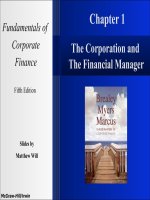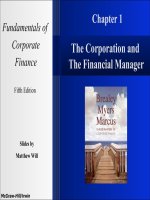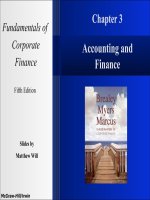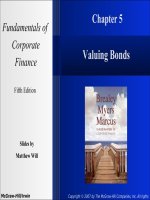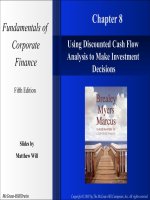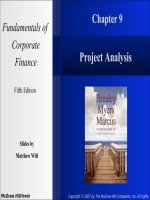Fundamentals of corporate finance 5e mcgraw chapter 09
Bạn đang xem bản rút gọn của tài liệu. Xem và tải ngay bản đầy đủ của tài liệu tại đây (479.49 KB, 23 trang )
Fundamentals of
Corporate
Finance
Chapter 9
Project Analysis
Fifth Edition
Slides by
Matthew Will
McGraw Hill/Irwin
Copyright © 2007 by The McGraw-Hill Companies, Inc. All rights
9- 2
Topics Covered
How Firms Organize the Investment Process
Some “What If” Questions
Sensitivity
Analysis
Scenario Analysis
Break Even Analysis
Real Options and the Value of Flexibility
McGraw-Hill/Irwin
Copyright © 2007 by The McGraw-Hill Companies, Inc. All rights
9- 3
Capital Budgeting Process
Capital Budget - The list of planned investment
projects.
The Decision Process
1 - Develop and rank all investment projects
2 - Authorize projects based on:
•
•
•
•
McGraw-Hill/Irwin
Outlays required by law of company policy
Maintenance of cost reduction
Capacity expansion in existing business
Investment for new products
Copyright © 2007 by The McGraw-Hill Companies, Inc. All rights
9- 4
Capital Budgeting Process
Capital Budgeting Problems
Consistent
forecasts
Conflict of interest
Forecast bias
Selection criteria (NPV and others)
McGraw-Hill/Irwin
Copyright © 2007 by The McGraw-Hill Companies, Inc. All rights
9- 5
How To Handle Uncertainty
Sensitivity Analysis - Analysis of the effects of changes in sales, costs, etc. on a project.
Scenario Analysis - Project analysis given a particular combination of assumptions.
Simulation Analysis - Estimation of the probabilities of different possible outcomes.
Break Even Analysis - Analysis of the level of sales (or other variable) at which the company breaks even.
McGraw-Hill/Irwin
Copyright © 2007 by The McGraw-Hill Companies, Inc. All rights
9- 6
Sensitivity Analysis
Example
Given the expected cash flow
forecasts listed on the next
slide, determine the NPV of
the project given changes in
the cash flow components
using an 8% cost of capital.
Assume that all variables
remain constant, except the
one you are changing.
McGraw-Hill/Irwin
Copyright © 2007 by The McGraw-Hill Companies, Inc. All rights
9- 7
Sensitivity Analysis
Example – continued (,000s)
Year 0
- 5,400
Investment
Sales
Variable Costs
Fixed Costs
Depreciation
Pretax profit
.Taxes @ 40%
Profit after tax
Operating cash flow
Net Cash Flow
- 5,400
Years 1 - 12
16,000
13,000
2,000
450
550
220
330
780
780
NPV= $478
McGraw-Hill/Irwin
Copyright © 2007 by The McGraw-Hill Companies, Inc. All rights
9- 8
Sensitivity Analysis
Example - continued
Possible Outcomes
Range
Variable Pessimistic Expected Optimistic
Investment (000s)
Sales(000s)
6,200
14,000
5,400
16,000
5,000
18,000
Var Cost (% of sales)
Fixed Costs(000s)
83%
2,100
81.25%
2,000
80%
1,900
McGraw-Hill/Irwin
Copyright © 2007 by The McGraw-Hill Companies, Inc. All rights
9- 9
Sensitivity Analysis
Example - continued
NPV Calculations for Pessimistic Investment Scenario
Year 0
Investment
Sales
Variable Costs
Years 1 - 12
- 6,200
16,000
13,000
Fixed Costs
2,000
Depreciation
Pretax profit
450
550
.Taxes @ 40%
Profit after tax
Operating cash flow
220
330
780
Net Cash Flow
- 6,200
780
NPV= ($121)
McGraw-Hill/Irwin
Copyright © 2007 by The McGraw-Hill Companies, Inc. All rights
9- 10
Sensitivity Analysis
Example - continued
NPV Possibilities
Variable Pessimistic
Investment (000s)
- 121
Sales(000s)
- 1,218
Var Cost (% of sales)
- 788
Fixed Costs(000s)
26
McGraw-Hill/Irwin
NPV (000s )
Expected Optimistic
478
778
478
2,174
478
1,382
478
930
Copyright © 2007 by The McGraw-Hill Companies, Inc. All rights
9- 11
Scenario Analysis
Example - continued
Cash Flows (years 1-12)
Base Case.
1. Sales
16,000,000
2. Variable costs
13,000,000
3.Fixed costs
2,000,000
4. Depreciation
450,000
5. Pretax profit (1 - 2 - 3 - 4)
550,000
6.Taxes
220,000
7. Profit after tax
330,000
8.Cash flow from operations (4 + 7)
780,000
Present value of cash flows
5,878,000
NPV
478,000
McGraw-Hill/Irwin
Competing Store Scenario.
13,600,000
11,152,000
2,000,000
450,000
- 2,000
- 800
- 1,200
448,000
3,382,000
- 2,018,000
Copyright © 2007 by The McGraw-Hill Companies, Inc. All rights
9- 12
Break Even Analysis
Example
Given the forecasted data
on the next slide,
determine the number of
planes that the company
must produce in order to
break even, on an NPV
basis. The company’s cost
of capital is 10%.
McGraw-Hill/Irwin
Copyright © 2007 by The McGraw-Hill Companies, Inc. All rights
9- 13
Break Even Analysis
Year 0 Years 1 - 6
Investment
$900
Sales
15.5xPlanes Sold
Var. Cost
8.5xPlanes Sold
Fixed Costs
175
Depreciation
900/6 = 150
Pretax Profit
(7xPlanes Sold) - 325
Taxes (50%)
(3.5xPlanes Sold) - 162.5
Net Profit
(3.5xPlanes Sold) - 162.5
Net Cash Flow - 900
(3.5xPlanes Sold) - 12.5
McGraw-Hill/Irwin
Copyright © 2007 by The McGraw-Hill Companies, Inc. All rights
9- 14
Break Even Analysis
Answer (Accounting)
The break even point, is the # of Planes Sold where the fixed costs and depreciation = $0.
0 = −( 3.5 x Planes Sold - 162.5)
Planes sold = 162.5/3.5 = 46.4 planes
McGraw-Hill/Irwin
Copyright © 2007 by The McGraw-Hill Companies, Inc. All rights
9- 15
Break Even Analysis
Answer (Finance)
The break even point, is the # of Planes
Sold that generates a NPV=$0.
The present value annuity factor of a 6
year cash flow at 10% is 4.355
Thus,
NPV = −900 + 4.355 ( 3.5 x Planes Sold - 12.5)
McGraw-Hill/Irwin
Copyright © 2007 by The McGraw-Hill Companies, Inc. All rights
9- 16
Break Even Analysis
Answer
Solving for “Planes Sold”
0 = −900 + 4.355 (3.5 xPlanes Sold - 12.5)
Planes Sold = 63
McGraw-Hill/Irwin
Copyright © 2007 by The McGraw-Hill Companies, Inc. All rights
9- 17
EVA & Break Even
1. Variable costs
81.25 percent of sales
2. Fixed costs
$2 million
3. Depreciation
$450,000
4. Pretax profit
(.1875 x sales) - $2.45 million
5. Tax (as 40%)
.40 x (.1875 x sales - $2.45 millions)
6. After - tax accounting profit
.60 x (.1875 x sales - $2.45 millions)
7. Cost of capital over and above allowed depreciation $266,553
8. Economic Value Added ( = line 6 - line 7)
McGraw-Hill/Irwin
.60 x (.1875 x sales - $2.45 millions) - $266,553
Copyright © 2007 by The McGraw-Hill Companies, Inc. All rights
9- 18
EVA & Break Even
EVA = accounting profit – additional cost of capital = 0
($3.5 x planes sold - $162.50) - $56.6 = 0
Planes sold = 219.1 / 3.5 = 62.6
McGraw-Hill/Irwin
Copyright © 2007 by The McGraw-Hill Companies, Inc. All rights
9- 19
Operating Leverage
Operating Leverage- The degree to which costs are fixed.
Degree of Operating Leverage (DOL) - Percentage change in profits given a 1 percent change in sales.
DOL =
McGraw-Hill/Irwin
% change in profits
% change in sales
Copyright © 2007 by The McGraw-Hill Companies, Inc. All rights
9- 20
Operating Leverage
Example - A company has sales outcomes that range from
$16mil to $19 mil, Depending on the economy. The same
conditions can produce profits in the range from $550,000
to $1,112,000. What is the DOL?
DOL =
McGraw-Hill/Irwin
102.2
18.75
= 5.45
Copyright © 2007 by The McGraw-Hill Companies, Inc. All rights
9- 21
Flexibility & Real Options
Decision Trees - Diagram of sequential decisions
and possible outcomes.
Decision trees help companies determine their
Options by showing the various choices and
outcomes.
The Option to avoid a loss or produce extra profit
has value.
The ability to create an Option thus has value that
can be bought or sold.
McGraw-Hill/Irwin
Copyright © 2007 by The McGraw-Hill Companies, Inc. All rights
9- 22
Decision Trees
Success
Test (Invest
$200,000)
Pursue project
NPV=$2million
Failure
Stop project
NPV=0
Don’t test
NPV=0
McGraw-Hill/Irwin
Copyright © 2007 by The McGraw-Hill Companies, Inc. All rights
9- 23
Real Options
1.
Option to expand
2.
Option to abandon
3.
Timing option
4.
Flexible production facilities
McGraw-Hill/Irwin
Copyright © 2007 by The McGraw-Hill Companies, Inc. All rights
